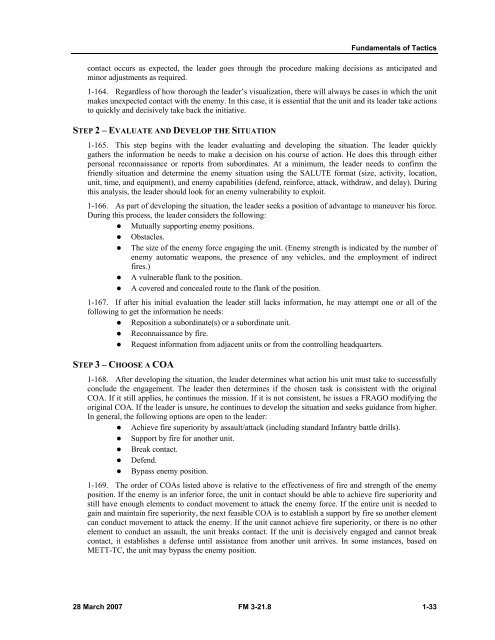Infantry Rifle Platoon and Squad - Sakai
Infantry Rifle Platoon and Squad - Sakai
Infantry Rifle Platoon and Squad - Sakai
Create successful ePaper yourself
Turn your PDF publications into a flip-book with our unique Google optimized e-Paper software.
Fundamentals of Tactics<br />
contact occurs as expected, the leader goes through the procedure making decisions as anticipated <strong>and</strong><br />
minor adjustments as required.<br />
1-164. Regardless of how thorough the leader’s visualization, there will always be cases in which the unit<br />
makes unexpected contact with the enemy. In this case, it is essential that the unit <strong>and</strong> its leader take actions<br />
to quickly <strong>and</strong> decisively take back the initiative.<br />
STEP 2 – EVALUATE AND DEVELOP THE SITUATION<br />
1-165. This step begins with the leader evaluating <strong>and</strong> developing the situation. The leader quickly<br />
gathers the information he needs to make a decision on his course of action. He does this through either<br />
personal reconnaissance or reports from subordinates. At a minimum, the leader needs to confirm the<br />
friendly situation <strong>and</strong> determine the enemy situation using the SALUTE format (size, activity, location,<br />
unit, time, <strong>and</strong> equipment), <strong>and</strong> enemy capabilities (defend, reinforce, attack, withdraw, <strong>and</strong> delay). During<br />
this analysis, the leader should look for an enemy vulnerability to exploit.<br />
1-166. As part of developing the situation, the leader seeks a position of advantage to maneuver his force.<br />
During this process, the leader considers the following:<br />
• Mutually supporting enemy positions.<br />
• Obstacles.<br />
• The size of the enemy force engaging the unit. (Enemy strength is indicated by the number of<br />
enemy automatic weapons, the presence of any vehicles, <strong>and</strong> the employment of indirect<br />
fires.)<br />
• A vulnerable flank to the position.<br />
• A covered <strong>and</strong> concealed route to the flank of the position.<br />
1-167. If after his initial evaluation the leader still lacks information, he may attempt one or all of the<br />
following to get the information he needs:<br />
• Reposition a subordinate(s) or a subordinate unit.<br />
• Reconnaissance by fire.<br />
• Request information from adjacent units or from the controlling headquarters.<br />
STEP 3 – CHOOSE A COA<br />
1-168. After developing the situation, the leader determines what action his unit must take to successfully<br />
conclude the engagement. The leader then determines if the chosen task is consistent with the original<br />
COA. If it still applies, he continues the mission. If it is not consistent, he issues a FRAGO modifying the<br />
original COA. If the leader is unsure, he continues to develop the situation <strong>and</strong> seeks guidance from higher.<br />
In general, the following options are open to the leader:<br />
• Achieve fire superiority by assault/attack (including st<strong>and</strong>ard <strong>Infantry</strong> battle drills).<br />
• Support by fire for another unit.<br />
• Break contact.<br />
• Defend.<br />
• Bypass enemy position.<br />
1-169. The order of COAs listed above is relative to the effectiveness of fire <strong>and</strong> strength of the enemy<br />
position. If the enemy is an inferior force, the unit in contact should be able to achieve fire superiority <strong>and</strong><br />
still have enough elements to conduct movement to attack the enemy force. If the entire unit is needed to<br />
gain <strong>and</strong> maintain fire superiority, the next feasible COA is to establish a support by fire so another element<br />
can conduct movement to attack the enemy. If the unit cannot achieve fire superiority, or there is no other<br />
element to conduct an assault, the unit breaks contact. If the unit is decisively engaged <strong>and</strong> cannot break<br />
contact, it establishes a defense until assistance from another unit arrives. In some instances, based on<br />
METT-TC, the unit may bypass the enemy position.<br />
28 March 2007 FM 3-21.8 1-33

















